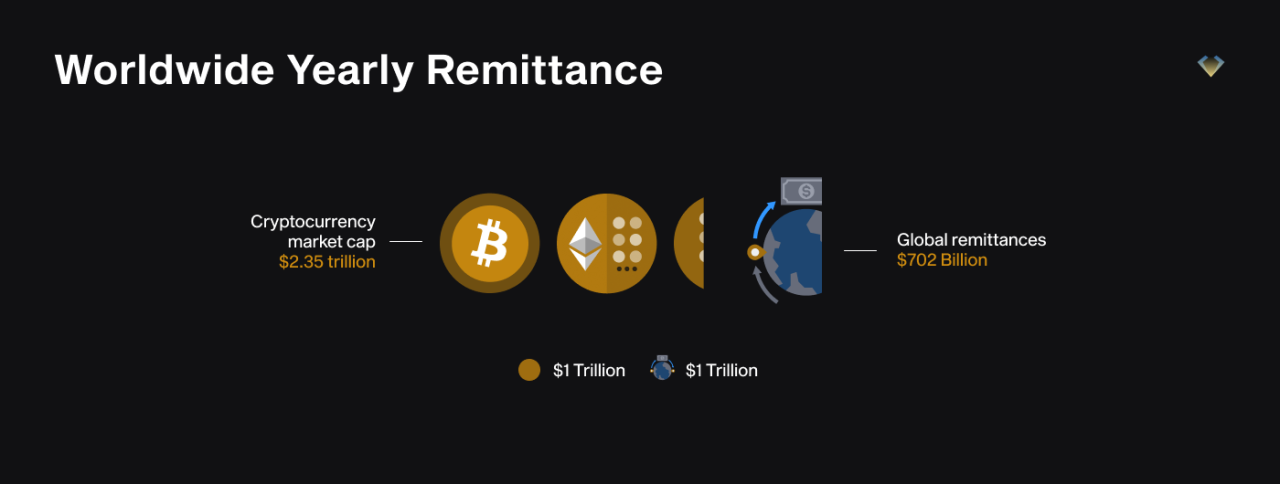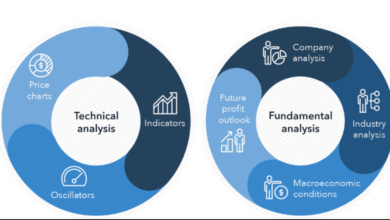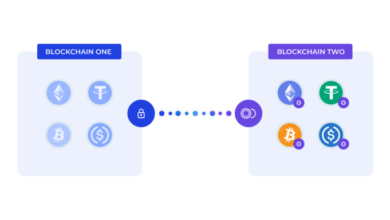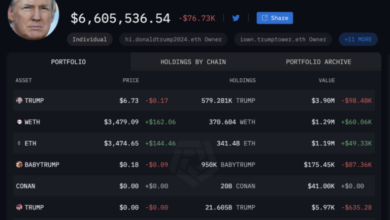
Understanding Traditional & Crypto Markets
Understanding the Relationship Between Traditional Markets and Crypto Assets delves into the intricate dance between established financial systems and the burgeoning world of digital currencies. We’ll explore the historical roots of traditional markets, from stock exchanges to bond markets, and contrast them with the revolutionary emergence of crypto assets. This exploration will analyze the fundamental principles, characteristics, and interplay of these two distinct but increasingly interconnected realms.
The evolution of these markets, from their initial stages to their current forms, will be examined. Key factors influencing their development, such as technological advancements, regulatory landscapes, and investment strategies, will be highlighted. We will also investigate the potential benefits and risks of integrating traditional and crypto investments, considering the impact of market fluctuations and regulatory influences.
Historical Context of Traditional Markets
Traditional financial markets, encompassing stock exchanges, bond markets, and other instruments, have a rich history shaped by various economic and social factors. Their evolution reflects changing societal needs and technological advancements. These markets, while distinct from crypto assets, share underlying principles of value exchange and risk management. Understanding their development provides context for analyzing the rise of cryptocurrencies.
Early Forms of Financial Markets
Early forms of financial markets existed in ancient civilizations, primarily for facilitating trade and lending. Barter systems evolved into more complex exchange mechanisms, leading to the development of rudimentary credit systems. These early markets laid the foundation for the sophisticated financial systems we see today. The emergence of paper currency and early forms of banking further facilitated transactions and credit arrangements.
Development of Stock Exchanges
The development of stock exchanges, beginning in the 17th century, marked a significant milestone in the evolution of financial markets. The Dutch East India Company’s stock market, established in the 1600s, is often cited as an early example. The creation of organized exchanges allowed for easier trading of shares, reducing transaction costs and increasing liquidity. Key events like the South Sea Bubble and the 1929 stock market crash underscore the volatility inherent in these markets.
Evolution of Bond Markets
Bond markets, crucial for long-term financing, evolved alongside stock exchanges. The issuance of government bonds to finance public projects, as well as corporate bonds to fund investments, became integral to capital formation. The development of sophisticated rating agencies further helped investors assess credit risk. The increasing complexity of bond markets is reflected in the various types of bonds and derivatives traded today.
Comparison with Crypto Asset Emergence
| Time Period | Event | Impact on Markets |
|---|---|---|
| 1600s-1800s | Development of stock and bond markets | Establishment of organized systems for trading securities, facilitating capital formation and economic growth. |
| Early 1900s | Stock market crash of 1929 | Demonstrated the inherent volatility and risks associated with traditional markets, highlighting the importance of regulation and risk management. |
| Mid-2000s | Rise of internet and online trading | Increased accessibility and efficiency in trading, connecting investors globally. |
| 2009 | Launch of Bitcoin | Introduction of a decentralized, digital asset class challenging traditional financial systems. |
The development of traditional financial markets was a gradual process spanning centuries, driven by economic needs and technological advancements. The emergence of crypto assets, in contrast, is a relatively recent phenomenon, occurring in the digital age, with a rapid growth rate. While traditional markets often involve intermediaries and centralized systems, crypto assets operate on decentralized networks.
Key Milestones and Influential Events
The history of traditional markets is punctuated by pivotal events that shaped their evolution. The South Sea Bubble, the 1929 stock market crash, and the rise of online trading are examples of major events that significantly impacted the development of financial markets. These events highlight the inherent volatility and risks associated with these markets.
Fundamental Principles of Traditional Markets
Traditional financial markets, built on centuries of experience, operate on a foundation of well-defined principles. These principles, while often complex, provide a framework for understanding how these markets function and the risks involved. From the basic interplay of supply and demand to the intricate mechanisms of regulation and risk management, these principles are crucial to maintaining stability and facilitating efficient allocation of capital.The fundamental principles of traditional financial markets are not static but evolve alongside economic and technological changes.
However, the core tenets remain consistent, providing a framework for navigating the complexities of investing and trading. Understanding these principles offers a crucial baseline for comprehending the unique characteristics of the burgeoning cryptocurrency market.
Supply and Demand
Supply and demand are fundamental forces driving prices in traditional markets. Higher demand for an asset typically leads to a price increase, while an oversupply often results in a decrease. This dynamic interplay is a constant in markets for stocks, bonds, commodities, and other financial instruments. For example, a sudden surge in demand for oil, driven by geopolitical events or increased industrial activity, can cause a significant price spike.
Conversely, a significant increase in the supply of a certain stock due to a company’s initial public offering (IPO) can lead to a price drop. This interplay shapes the pricing dynamics of assets in traditional financial markets.
Risk Management
Risk management is a critical aspect of traditional markets, aiming to mitigate potential losses. Investors and financial institutions use various strategies to assess and manage risks associated with different assets and transactions. Diversification, hedging, and stop-loss orders are common risk management tools. Diversification involves spreading investments across various asset classes to reduce the impact of a single investment’s poor performance.
Hedging involves using financial instruments to offset potential losses from adverse price movements in a specific asset. Stop-loss orders are used to limit potential losses by automatically selling an asset when it reaches a predetermined price. Successful risk management is essential for maintaining market stability and investor confidence.
Regulation
Government regulations play a crucial role in maintaining the integrity and stability of traditional markets. Regulations aim to prevent fraudulent activities, protect investors, and ensure fair market practices. Regulations vary significantly by jurisdiction, reflecting diverse cultural and economic contexts. For instance, regulations concerning insider trading, market manipulation, and financial reporting differ across countries, impacting how financial institutions operate and how investors interact with markets.
The goal is to balance the need for market freedom with the need for consumer protection and market integrity.
Role of Intermediaries
Intermediaries play a vital role in facilitating transactions and information flow within traditional markets. Brokers, exchanges, and banks are key intermediaries. Brokers act as agents connecting buyers and sellers, facilitating trades. Exchanges provide platforms for trading various financial instruments, ensuring transparency and order execution. Banks play a critical role in lending, borrowing, and managing funds, influencing liquidity and investment opportunities.
The efficiency of these intermediaries is a key determinant of market liquidity and overall functioning.
Price Discovery and Market Efficiency
Price discovery is the process by which market prices reflect the underlying value of an asset. In traditional markets, various mechanisms contribute to price discovery, including order books, auction markets, and continuous trading. Market efficiency refers to the speed and accuracy with which prices reflect available information. Highly efficient markets quickly incorporate new information into prices, leading to fair valuations.
Factors influencing market efficiency include the transparency of information, the number of market participants, and the speed of information dissemination.
Comparison of Traditional and Crypto Market Mechanisms
| Feature | Traditional Markets | Crypto Markets |
|---|---|---|
| Market Structure | Established exchanges, regulated intermediaries | Decentralized exchanges, often lacking centralized oversight |
| Price Discovery | Based on supply and demand, often through order books and auctions | Driven by algorithmic trading, order books, and market sentiment |
| Liquidity | Generally high liquidity due to established trading mechanisms | Liquidity can be volatile, influenced by market sentiment and trading volume |
| Regulation | Extensive regulatory frameworks | Generally less regulated, with varying levels of regulatory oversight across jurisdictions |
| Intermediaries | Brokers, exchanges, banks | Decentralized protocols, automated market makers |
Crypto Asset Characteristics
Crypto assets, a rapidly evolving segment of the financial world, differ significantly from traditional markets. Understanding these distinctions is crucial for investors and analysts alike. Their unique characteristics, including decentralization, blockchain technology, and inherent volatility, have profoundly impacted the way markets function and create new opportunities. The potential for both substantial returns and significant losses is a key factor to consider.The decentralized nature of crypto assets, often operating outside traditional regulatory frameworks, is a defining feature.
This decentralized structure, while offering advantages in terms of transparency and accessibility, also presents challenges related to regulation and security. Different crypto assets have various functionalities, and these functionalities, in turn, drive demand and supply in the markets. Understanding these functionalities and the underlying factors that drive these markets is essential for navigating the complexities of this emerging asset class.
Decentralization and Blockchain Technology
Crypto assets are built on blockchain technology, a distributed ledger system that records transactions across multiple computers. This decentralized nature removes the need for intermediaries like banks or clearinghouses, potentially reducing costs and increasing transparency. However, this decentralized approach also poses challenges regarding regulation and enforcement.
Types of Crypto Assets
Crypto assets encompass a diverse range of digital tokens. Bitcoin, the pioneering cryptocurrency, serves as a decentralized digital currency. Ethereum, a platform for decentralized applications (dApps), is notable for its smart contract functionality. Stablecoins aim to mitigate the volatility inherent in other cryptocurrencies by pegging their value to a stable asset like the US dollar.
Key Drivers of Demand and Supply
Several factors influence the demand and supply dynamics in crypto markets. Investor sentiment, technological advancements, regulatory developments, and overall market confidence play significant roles. News events, both positive and negative, can drastically shift market sentiment and influence price movements. For example, announcements regarding regulatory changes or technological breakthroughs can cause significant price fluctuations.
Crypto Asset Risk Assessment
| Crypto Asset Type | Associated Risks |
|---|---|
| Bitcoin | High volatility, regulatory uncertainty, security risks, price manipulation, and market crashes |
| Ethereum | Decentralized application risks, smart contract vulnerabilities, security risks related to dApps, market fluctuations |
| Stablecoins | Liquidity risks, risks associated with the pegged asset, counterparty risk, and security risks of the underlying collateral |
| Other Altcoins | Project risk, team risk, market acceptance risk, and technological risks |
The table above illustrates the diverse risk profiles associated with different crypto asset types. Each type of crypto asset carries a unique set of risks that investors should carefully consider before engaging in trading.
Interplay Between Traditional and Crypto Markets

Source: storyblok.com
The convergence of traditional and crypto markets is a complex phenomenon, marked by both exciting possibilities and significant risks. Understanding the intricate relationship between these two worlds is crucial for investors and market participants alike. This interplay is characterized by the mirroring of certain market behaviors, but also by unique characteristics that differentiate them. The integration of crypto assets into traditional financial systems is still ongoing, and the future implications are yet to be fully realized.The interplay between traditional and crypto markets involves a complex dance of similarities and differences.
While both markets aim to facilitate the exchange of value, the underlying technologies, regulatory frameworks, and investment strategies differ significantly. Crypto markets, with their decentralized nature and often volatile price swings, present a unique challenge and opportunity for investors familiar with traditional markets.
Investment Strategies
Traditional markets rely on established investment strategies such as fundamental analysis, technical analysis, and diversification. Crypto markets, while also utilizing these approaches, are often driven by factors like community sentiment, hype, and technological advancements. This difference in driving forces creates a dynamic interaction between the two, with traditional investors sometimes looking to crypto for alternative returns, and crypto investors leveraging traditional market knowledge for diversification.
Potential Benefits and Risks of Integration
Integrating traditional and crypto investments can yield substantial benefits, such as access to potentially higher returns and diversification of investment portfolios. However, the inherent volatility of crypto markets presents a significant risk to investors who may not be adequately prepared for the rapid fluctuations. Careful consideration of risk tolerance and investment goals is paramount. Examples of successful integration include institutional investors incorporating cryptocurrencies into their portfolios, but these instances often involve significant due diligence and risk management protocols.
Impact of Crypto Market Fluctuations on Traditional Markets
Crypto market fluctuations can influence traditional markets through several channels. A sharp decline in the crypto market can trigger a domino effect, impacting the valuations of related traditional assets like blockchain technology companies. Conversely, positive developments in the crypto space can create a ripple effect, stimulating interest in similar technologies and financial products in traditional markets. For instance, the rise and fall of Bitcoin in 2021 significantly influenced the market sentiment towards other digital assets and innovative financial instruments.
Regulation’s Influence
Regulation plays a crucial role in shaping the relationship between traditional and crypto markets. Varying regulatory approaches across jurisdictions can create a complex landscape for investors and businesses operating in both sectors. Governments worldwide are still grappling with how to effectively regulate cryptocurrencies, and this uncertainty can impact investor confidence and market stability. The introduction of specific regulations in various countries, like the recent crypto-specific laws in the United States, demonstrates the growing recognition of the need for clearer frameworks to manage the interaction between traditional and crypto assets.
Regulatory Landscape

Source: ytimg.com
The regulatory landscape surrounding both traditional markets and crypto assets is a complex and evolving area. Traditional markets have a long history of established regulations, while the crypto market is still in its relative infancy, leading to differing approaches and varying degrees of effectiveness. Understanding these differences is crucial to comprehending the evolving relationship between these two distinct but increasingly interconnected sectors.
The lack of a globally unified regulatory framework poses challenges in fostering trust and stability.The current regulatory environment for both traditional and crypto markets is marked by a spectrum of approaches. Some jurisdictions take a hands-off approach, while others employ more stringent regulations. These differences in regulatory frameworks reflect the unique characteristics of each market, including their inherent risks, the potential for innovation, and the need to protect investors.
The interplay between these diverse approaches significantly impacts how traditional and crypto markets interact, shaping their respective development and future growth.
Regulatory Approaches in Traditional Markets
Traditional markets, encompassing equities, bonds, and commodities, have a long-standing history of regulation. This history has resulted in a diverse set of regulations tailored to specific asset classes. Regulations are primarily aimed at protecting investors, maintaining market integrity, and preventing fraudulent activities. The development of these regulations has been iterative, adapting to market changes and technological advancements.
Examples include securities regulations, banking regulations, and commodity regulations.
Regulatory Approaches in Crypto Markets
Crypto markets are characterized by decentralized systems, rapid innovation, and the use of novel technologies. The regulatory environment for crypto assets is still developing globally. Jurisdictions are grappling with how to regulate these assets while balancing the need for innovation and consumer protection. Different approaches are being taken, including outright bans, licensing frameworks, and regulatory sandboxes. The challenges in regulating crypto stem from its decentralized nature, the lack of a single global standard, and the inherent volatility of the market.
Figuring out how traditional markets and crypto assets relate is tricky, right? It’s like trying to find the perfect balance between natural remedies and modern medicine. Just as certain spices, like clove and black nutmeg, can offer natural digestive support, as explored in this insightful article on Clove and Black Nutmeg: Natural Remedies for Better Digestion , understanding the connections between traditional finance and the digital realm requires a similar approach.
Both require careful consideration and a nuanced understanding to truly grasp their impact.
Comparative Analysis of Regulatory Frameworks
| Country | Traditional Markets Regulation | Crypto Markets Regulation | Key Differences |
|---|---|---|---|
| United States | Well-established framework encompassing securities, commodities, and banking regulations. | Evolving framework with a mix of federal and state regulations, focusing on securities and money laundering concerns. | Crypto regulations are still developing and face challenges in aligning with existing traditional market frameworks. |
| European Union | Harmonized regulations across member states for financial markets. | Developing regulatory proposals aiming for a harmonized approach to crypto assets, focusing on investor protection and market integrity. | The EU is attempting to create a unified approach to crypto regulation, but the implementation and enforcement remain complex. |
| China | Comprehensive regulatory framework for traditional markets, with a focus on control and stability. | More stringent approach, including outright bans on certain crypto activities. | China’s regulatory stance is significantly more restrictive compared to other jurisdictions. |
Challenges and Opportunities
The varied regulatory approaches present both challenges and opportunities for the relationship between traditional and crypto markets. Challenges include the lack of global harmonization, conflicting regulations, and the need for adaptability to rapid technological advancements in the crypto space. Opportunities arise from the potential for greater investor protection, improved market transparency, and a more stable regulatory environment for crypto assets.
The potential for cross-border cooperation and knowledge sharing between traditional and crypto markets also presents an opportunity.
Examples of Regulatory Approaches
Different jurisdictions have adopted various approaches to regulate crypto markets. For example, some jurisdictions have introduced licensing requirements for crypto exchanges, while others have focused on anti-money laundering regulations. The specific approaches vary widely, reflecting the unique characteristics and priorities of each jurisdiction. These regulatory efforts aim to mitigate risks, protect investors, and promote the responsible development of the crypto market.
Investment Strategies
Navigating the world of investments, whether in traditional markets or the burgeoning crypto sphere, requires a well-defined strategy. Different approaches cater to various risk tolerances and investment goals. Understanding the nuances of these strategies is crucial for informed decision-making.
Traditional Market Investment Strategies
Traditional markets offer a diverse array of investment strategies, each with its own characteristics and potential rewards. Value investing, for instance, focuses on identifying undervalued assets with the potential for substantial future appreciation. Growth investing, on the other hand, targets companies with strong revenue and earnings growth, expecting their stock prices to rise significantly over time. These strategies differ substantially from one another, reflecting varying risk profiles.
- Value Investing: This approach seeks out companies trading below their intrinsic value, believing that the market has temporarily underestimated their true worth. Investors typically analyze financial statements, industry trends, and management quality to identify potential bargains. For example, Berkshire Hathaway, managed by Warren Buffett, is a prime example of a value-driven investment strategy that has generated substantial returns over decades.
- Growth Investing: This strategy focuses on companies with high growth potential. Investors anticipate substantial future revenue and earnings increases, leading to significant price appreciation. Companies in emerging sectors like technology or renewable energy are often targets for growth investors. Examples include Amazon’s initial surge in the early 2000s, reflecting investors’ confidence in its growth trajectory.
- Index Funds and ETFs: These investment vehicles provide broad exposure to a specific market index, like the S&P 500. They offer diversification and often lower management fees compared to actively managed funds. This passive approach simplifies investment portfolios.
Crypto Market Investment Strategies
The crypto market, with its inherent volatility, presents unique investment strategies. Day trading, often associated with high-frequency trading, involves rapidly buying and selling cryptocurrencies to capitalize on short-term price fluctuations. HODLing, a term stemming from the verb “holding,” is a long-term strategy where investors maintain their cryptocurrency holdings, believing in the potential for significant price appreciation. This strategy contrasts with the quick-paced day trading and other crypto strategies.
- Day Trading: This involves actively buying and selling cryptocurrencies within a single trading day. It’s crucial to understand the risks involved as the market can be highly volatile, and rapid price changes can lead to significant losses. Day traders often rely on technical analysis to identify short-term trading opportunities.
- HODLing: This long-term investment strategy involves holding onto cryptocurrencies for an extended period. It’s based on the belief that the asset’s value will increase over time. While it can yield substantial returns, it also exposes investors to significant price fluctuations and market risks.
- Algorithmic Trading: Using computer programs to execute trades based on pre-defined rules and strategies. These strategies can be highly effective in managing large portfolios and executing complex trading operations.
Diversification in Both Markets
Diversification is paramount in mitigating risk in both traditional and crypto markets. By spreading investments across various assets, investors reduce the impact of any single investment’s poor performance. This strategy is crucial in both markets due to their inherent volatility and the potential for unforeseen events. It is important to note that diversification does not guarantee profits, but it helps to reduce losses.
Successful Investment Strategies Examples
Successful investment strategies often combine in-depth research, risk assessment, and adaptability. Examples of successful strategies in traditional markets include the long-term success of companies like Apple and Microsoft, driven by innovative products and consistent revenue streams. Similarly, the rise of Bitcoin, and other successful crypto projects, demonstrate the potential for substantial gains, but also the substantial risks associated with the market.
Figuring out how traditional markets and crypto assets relate is key. Understanding their distinct characteristics is crucial for building a robust investment strategy, like the one discussed in Creating a Balanced Investment Strategy Between Traditional Markets and Crypto. Ultimately, a balanced approach, combining both, can lead to a more diversified and potentially higher-reward portfolio, while still recognizing the inherent risks associated with any investment.
This interplay between traditional and crypto markets remains an area of active exploration.
Technological Advancements
The relentless march of technological progress is reshaping the landscape of both traditional and crypto markets. Artificial intelligence, machine learning, and blockchain technology are driving innovation, altering investment strategies, and impacting market efficiency in profound ways. These advancements are creating opportunities for both investors and businesses, while simultaneously introducing new challenges and complexities.
Impact of AI and Machine Learning on Traditional Markets
AI and machine learning algorithms are increasingly being used to analyze vast datasets, identify patterns, and predict market trends in traditional financial markets. These tools can automate tasks, enhance risk management, and personalize investment strategies for individual clients. For instance, sophisticated algorithms are now used to detect fraudulent transactions, optimize portfolio allocations, and even predict stock price movements with a degree of accuracy.
This automation leads to faster processing speeds and reduced human error.
Transformation of Investment Processes by Blockchain Technology
Blockchain technology is transforming investment processes in the crypto space and, increasingly, in traditional markets. Decentralized finance (DeFi) platforms leverage blockchain to create transparent and secure financial instruments and trading opportunities. This technology eliminates intermediaries, reduces transaction costs, and increases efficiency. Tokenization of assets, such as real estate or art, is also facilitated by blockchain, opening up new avenues for investment.
Furthermore, blockchain’s immutability and transparency enhance trust and security in transactions.
Improving Market Efficiency and Transparency through Technology
Technological advancements are significantly improving market efficiency and transparency. Real-time data feeds and sophisticated trading algorithms enable faster execution of trades and reduced latency. This translates to improved liquidity and reduced market volatility. Moreover, the increased accessibility and availability of data, coupled with analytical tools, enhance transparency. Investors can access more information, allowing them to make more informed decisions, which in turn, contributes to fairer markets.
Innovation in Traditional and Crypto Markets
Advancements in technology are fueling innovation in both traditional and crypto markets. High-frequency trading, algorithmic trading, and automated portfolio management are examples of how traditional markets are leveraging technology. Meanwhile, crypto markets are witnessing the development of decentralized exchanges (DEXs), non-fungible tokens (NFTs), and stablecoins, all driven by the potential of blockchain. This innovation is creating new products, services, and opportunities, but also raises important questions about regulatory frameworks and risk management.
Market Trends: Understanding The Relationship Between Traditional Markets And Crypto Assets
The dynamic interplay between traditional and crypto markets is heavily influenced by a multitude of factors. Understanding these trends is crucial for investors and market participants to navigate the complexities of both asset classes. From macroeconomic shifts to emerging technologies, the landscape is constantly evolving, demanding a nuanced approach to risk assessment and investment strategies.The current market landscape is characterized by volatility and uncertainty, particularly for both traditional and crypto assets.
Factors such as rising interest rates, inflation concerns, and geopolitical tensions are impacting traditional markets, while the regulatory environment and the adoption of cryptocurrencies by institutional investors are shaping the crypto space. This analysis delves into the specific trends shaping both sectors.
Current Market Trends Impacting Both Traditional and Crypto Markets
Several key trends are shaping both traditional and crypto markets. These trends often overlap and influence each other, creating a complex interconnected system.
Digging into the interplay between traditional markets and crypto assets is fascinating. While researching this, I stumbled across some compelling reasons to incorporate moringa leaves into my diet for a healthier lifestyle. Top Reasons to Include Moringa Leaves in Your Diet for Better Health highlights the nutritional power of this often-overlooked ingredient. Ultimately, understanding the unique dynamics of traditional markets and crypto assets is crucial for navigating the evolving financial landscape.
- Rising Interest Rates: Central banks worldwide are raising interest rates to combat inflation. This impacts traditional markets by increasing borrowing costs and potentially slowing economic growth. It also affects crypto markets, as higher rates can reduce investor interest in riskier assets like cryptocurrencies, leading to lower prices and reduced trading volume.
- Inflationary Pressures: Inflationary pressures are putting downward pressure on the purchasing power of traditional currencies. This can lead to increased demand for assets like gold and potentially cryptocurrencies, which some perceive as a hedge against inflation. The degree of this effect varies based on perceived stability and regulatory environments for each asset class.
- Geopolitical Uncertainty: Global events, including geopolitical tensions and conflicts, can create market volatility in both traditional and crypto markets. Uncertainty often leads to risk aversion, affecting investor sentiment and market performance.
- Technological Advancements: Emerging technologies like blockchain and decentralized finance (DeFi) are revolutionizing financial systems and creating new opportunities in both traditional and crypto markets. These advancements have the potential to streamline processes and increase efficiency, but also bring new risks and complexities.
Influence of Macroeconomic Factors on Both Traditional and Crypto Markets
Macroeconomic factors play a significant role in shaping the behavior of both traditional and crypto markets. These factors can influence investor sentiment, investment strategies, and overall market performance.
- Interest Rate Hikes: Rising interest rates can increase the attractiveness of fixed-income investments, potentially diverting capital from riskier assets like cryptocurrencies. Conversely, higher rates might also lead to a reduction in traditional investment returns, creating an incentive to explore alternatives like cryptocurrencies.
- Inflationary Pressures: High inflation can erode the purchasing power of traditional currencies, potentially driving investors toward assets perceived as inflation hedges, such as gold and, in some cases, cryptocurrencies.
- Economic Slowdowns: Economic downturns often correlate with increased risk aversion in traditional markets, leading to capital flight to perceived safe-haven assets. Crypto markets can exhibit similar responses, but their relationship to traditional economic cycles is still evolving.
Emerging Technologies and Their Potential Impact on the Relationship Between Traditional and Crypto Markets
Emerging technologies are reshaping the landscape of both traditional and crypto markets.
- Decentralized Finance (DeFi): DeFi platforms are offering alternative financial services that bypass traditional intermediaries. This has the potential to revolutionize financial access and efficiency, potentially creating new investment opportunities and challenges for traditional financial institutions.
- Non-Fungible Tokens (NFTs): NFTs represent unique digital assets, creating new avenues for investment and artistic expression. They are influencing traditional art markets and creating new business models.
- Central Bank Digital Currencies (CBDCs): The development and implementation of CBDCs could fundamentally change the landscape of traditional finance and potentially impact the adoption and use of cryptocurrencies. This development could introduce new regulatory challenges and opportunities.
Summary of Trends
| Trend | Impact on Traditional Markets | Impact on Crypto Markets |
|---|---|---|
| Rising Interest Rates | Increased borrowing costs, potential economic slowdown | Reduced investor interest, lower prices |
| Inflationary Pressures | Erosion of purchasing power, potential search for alternatives | Potential increase in demand as hedge |
| Geopolitical Uncertainty | Market volatility, risk aversion | Market volatility, risk aversion |
| Technological Advancements (DeFi, NFTs, CBDCs) | Disruption of traditional financial services, new investment opportunities | New investment opportunities, potential regulatory challenges |
Illustrative Case Studies
The intersection of traditional and crypto markets is a dynamic landscape, rife with both opportunities and challenges. Understanding how these two spheres interact requires examining real-world examples, both successful and problematic, to glean key lessons for future investment and innovation. Case studies offer tangible insights into the complexities and potential pitfalls of integrating these distinct asset classes.
Successful Integration Examples
The integration of crypto assets into traditional financial systems has shown potential, although it’s still a nascent area. Examples include institutional adoption of Bitcoin as a store of value, and the development of crypto-backed securities.
- Institutional Investment in Bitcoin: Some large institutional investors have begun to include Bitcoin in their portfolios. This demonstrates a growing acceptance of crypto assets within traditional investment strategies. For example, MicroStrategy’s substantial Bitcoin holdings highlight this trend.
- Crypto-backed Securities: These securities aim to bridge the gap between traditional finance and crypto by leveraging the value of crypto assets to create tradable instruments. This approach allows traditional investors to gain exposure to the crypto market without direct involvement in cryptocurrencies themselves. This approach can be a safer way to access the crypto market.
Challenges in Integration, Understanding the Relationship Between Traditional Markets and Crypto Assets
Despite some successes, integrating traditional and crypto markets also presents numerous hurdles. Volatility, regulatory uncertainty, and the lack of established infrastructure pose considerable obstacles.
- Volatility of Crypto Markets: Crypto asset prices are notoriously volatile, which can create significant risk for investors seeking to integrate them into traditional portfolios. The price swings can lead to substantial losses if not managed carefully.
- Regulatory Uncertainty: The evolving regulatory landscape surrounding crypto assets presents challenges for traditional financial institutions seeking to participate. The lack of clear and consistent regulations across jurisdictions can deter adoption and create investment uncertainty.
- Lack of Established Infrastructure: The infrastructure supporting crypto assets, including exchanges and custody services, often lacks the maturity and security of traditional financial systems. This can lead to operational risks and security vulnerabilities for institutional investors.
Key Lessons Learned
The experiences of integrating traditional and crypto markets offer valuable lessons. Diversification, risk management, and regulatory awareness are crucial elements for navigating this complex landscape.
“Successful integration requires a nuanced understanding of both traditional and crypto markets, encompassing risk management strategies tailored to the unique characteristics of each.”
- Diversification is Key: Diversifying a portfolio by including both traditional and crypto assets can potentially enhance returns and mitigate risks. However, the specific allocation needs careful consideration given the different characteristics of each asset class.
- Thorough Risk Management: Understanding and managing the inherent risks associated with both traditional and crypto markets is paramount. This includes assessing volatility, regulatory risks, and potential security vulnerabilities.
- Regulatory Awareness: Staying informed about the evolving regulatory landscape surrounding crypto assets is crucial for investors and institutions. Compliance with relevant regulations is essential for avoiding legal and financial penalties.
Conclusion
In conclusion, the relationship between traditional and crypto markets is complex and dynamic, marked by both opportunities and challenges. The interplay of historical context, fundamental principles, technological advancements, and regulatory landscapes shapes the trajectory of both sectors. Understanding this intricate relationship is crucial for investors and stakeholders navigating the evolving financial landscape.
FAQ Section
What are some examples of successful investment strategies in traditional markets?
Value investing, growth investing, and dividend investing are examples of successful strategies in traditional markets. These strategies often focus on different aspects of a company’s performance and potential for future growth.
How does blockchain technology impact investment processes?
Blockchain technology can improve transparency and efficiency in investment processes by providing a secure and immutable record of transactions. This can lead to reduced costs and increased trust among participants.
What are the key differences between traditional and crypto market mechanisms?
Traditional markets often rely on intermediaries like brokers and exchanges, while crypto markets tend to be decentralized, with peer-to-peer transactions being more common. Price discovery mechanisms and regulatory frameworks also differ significantly.
What are the potential benefits and risks of integrating traditional and crypto investments?
Integrating traditional and crypto investments can offer diversification benefits and potentially higher returns, but also introduces risks related to volatility and regulatory uncertainty. Careful risk management is essential.






